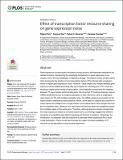| dc.contributor.author | Das, Dipjyoti | en_US |
| dc.contributor.author | Dey, Supravat | en_US |
| dc.contributor.author | Brewster, Robert C. | en_US |
| dc.contributor.author | Choubey, Sandeep | en_US |
| dc.date.accessioned | 2017-06-15T18:31:17Z | |
| dc.date.issued | 2017 | en_US |
| dc.identifier.citation | Das, Dipjyoti, Supravat Dey, Robert C. Brewster, and Sandeep Choubey. 2017. “Effect of transcription factor resource sharing on gene expression noise.” PLoS Computational Biology 13 (4): e1005491. doi:10.1371/journal.pcbi.1005491. http://dx.doi.org/10.1371/journal.pcbi.1005491. | en |
| dc.identifier.issn | | en |
| dc.identifier.uri | http://nrs.harvard.edu/urn-3:HUL.InstRepos:33029985 | |
| dc.description.abstract | Gene expression is intrinsically a stochastic (noisy) process with important implications for cellular functions. Deciphering the underlying mechanisms of gene expression noise remains one of the key challenges of regulatory biology. Theoretical models of transcription often incorporate the kinetics of how transcription factors (TFs) interact with a single promoter to impact gene expression noise. However, inside single cells multiple identical gene copies as well as additional binding sites can compete for a limiting pool of TFs. Here we develop a simple kinetic model of transcription, which explicitly incorporates this interplay between TF copy number and its binding sites. We show that TF sharing enhances noise in mRNA distribution across an isogenic population of cells. Moreover, when a single gene copy shares it’s TFs with multiple competitor sites, the mRNA variance as a function of the mean remains unaltered by their presence. Hence, all the data for variance as a function of mean expression collapse onto a single master curve independent of the strength and number of competitor sites. However, this result does not hold true when the competition stems from multiple copies of the same gene. Therefore, although previous studies showed that the mean expression follows a universal master curve, our findings suggest that different scenarios of competition bear distinct signatures at the level of variance. Intriguingly, the introduction of competitor sites can transform a unimodal mRNA distribution into a multimodal distribution. These results demonstrate the impact of limited availability of TF resource on the regulation of noise in gene expression. | en |
| dc.language.iso | en_US | en |
| dc.publisher | Public Library of Science | en |
| dc.relation.isversionof | doi:10.1371/journal.pcbi.1005491 | en |
| dc.relation.hasversion | http://www.ncbi.nlm.nih.gov/pmc/articles/PMC5411101/pdf/ | en |
| dash.license | LAA | en_US |
| dc.subject | Biology and Life Sciences | en |
| dc.subject | Genetics | en |
| dc.subject | Gene Expression | en |
| dc.subject | Biology and life sciences | en |
| dc.subject | Biochemistry | en |
| dc.subject | Nucleic acids | en |
| dc.subject | RNA | en |
| dc.subject | Messenger RNA | en |
| dc.subject | Gene expression | en |
| dc.subject | DNA transcription | en |
| dc.subject | Gene Regulation | en |
| dc.subject | Evolutionary Biology | en |
| dc.subject | Population Genetics | en |
| dc.subject | Gene Pool | en |
| dc.subject | Population Biology | en |
| dc.subject | Proteins | en |
| dc.subject | DNA-binding proteins | en |
| dc.subject | Transcription Factors | en |
| dc.subject | Regulatory Proteins | en |
| dc.subject | Cell Biology | en |
| dc.subject | Cell Physiology | en |
| dc.subject | Cell Binding | en |
| dc.title | Effect of transcription factor resource sharing on gene expression noise | en |
| dc.type | Journal Article | en_US |
| dc.description.version | Version of Record | en |
| dc.relation.journal | PLoS Computational Biology | en |
| dash.depositing.author | Choubey, Sandeep | en_US |
| dc.date.available | 2017-06-15T18:31:17Z | |
| dc.identifier.doi | 10.1371/journal.pcbi.1005491 | * |
| dash.contributor.affiliated | Choubey, Sandeep | |


